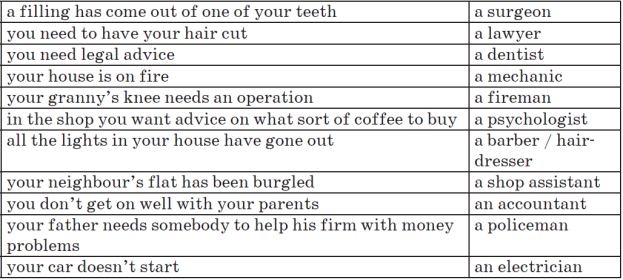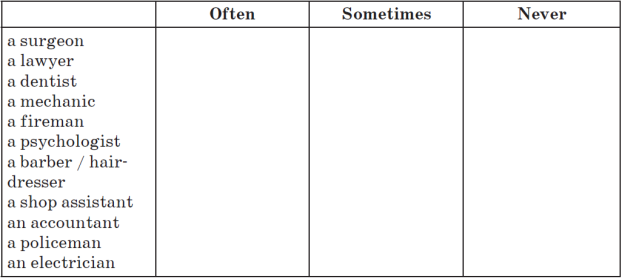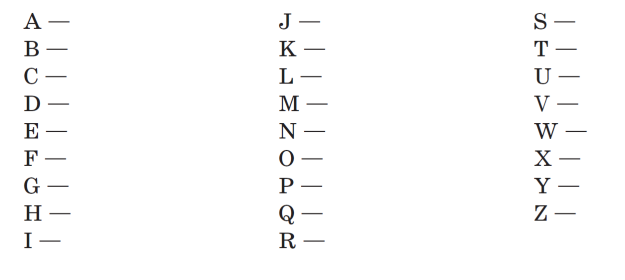Урок формування комунікативної компетентності учнів
Aims and objectives:
• introducing vocabulary
• developing basic skills
Equipment: writing paper, pictures, handouts
I. Warming-up
The teacher may either use the warming-up activities desrcibed earlier or invent the ones of his / her own.
1. Introducing vocabulary
Who would you contact or call in the situations given below?
Match the situations in the left column with the name of the job or profession in the right column.
Then the students work individually and fill in the chart. A few may be asked to report their answers with explanations.
How often do you have to consult these specialists? Why?
Look at the picture with a partner. Decide what jobs the people are doing and label the pictures. Discuss what training is needed to do the job. Talk about one good and one bad point of this kind of work.
The teacher prepares pictures describing lawyer, surgeon, shop assistant, dentist, fireman, electrician, psychologist, barber / hairdresser, policeman, mechanic and shows them to students.
Does anyone in your family do any of these jobs? Which one(s)? what training has the person got for it? What does he / she like / dislike about the job? Is it the same thing you like / dislike about it? Why / why not?
Finish the following sentences with the names of jobs or professions given below.
1) A person who deals with office correspondence and records is a __ .
2) A person whose job is to treat sick animals is a __ .
3) A person who checks in and out books and gives advice on what to read is a __ .
4) A person who gets coal from under the ground is a __ .
5) A person who loads and unloads ships in a port is a __ .
6) A person whose job is to cook in a restaurant is a __ .
7) A person who sells newspapers and magazines is a __ .
8) A person who works in a government office is a __ .
9) A person whose job is to help people buy and sell houses is a __ .
10) A person who designs buildings is an __ .
3. Brainstorming / Vocabulary
You only have five minutes.
When you finish, the class can make a master list for the board.
Each group gets 1 point for a correct answer and 2 points if the answer is also original. Good luck.
Example: A architect
The master list must be made and posted in the classroom as a visual aid. Students may also add there the hames of jobs while working on the topic.
Now think about the job you would like to do or one you are familiar with. Use the chart to brainstorm the good and bad things about your job. Then talk to a classmate about it.
Job
IV. Homework
Find the names of jobs to complete the ABC list with descriptions and sample sentences; use the chart in activity 6 to make a written characteristic of your job.


про публікацію авторської розробки
Додати розробку




